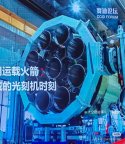Interview: China's lunar exploration achieves systematic progress, says chief designer
Source: Xinhua
Editor: huaxia
2025-04-02 00:14:15
BEIJING, April 1 (Xinhua) -- China's lunar exploration program has made systematic advancements across scientific research, technological innovation, engineering development and international collaboration over the past two decades, Wu Weiren, the chief designer of China's lunar exploration program, told Xinhua.
Wu made the remarks in an interview on Tuesday at the opening of an exhibition at the National Museum of China, which highlights two decades of the country's lunar exploration program.
Wu noted that China's lunar exploration program has produced a wealth of geological and environmental data, uncovering new elements, minerals and phenomena -- greatly enriching humanity's knowledge of the moon.
He said that China has not only achieved breakthroughs in core aerospace technologies, but has also established a unique lunar exploration project system and formed a relatively complete infrastructure system.
"Furthermore, the country has actively promoted international collaboration through data-sharing and joint research initiatives, significantly advancing global lunar exploration efforts," he said.
Looking ahead, Wu said that China plans to launch the Chang'e-7 mission around 2026 to explore the environment and resources of the south pole of the moon. The Chang'e-8 mission, set for around 2028, will conduct experiments for the in-situ utilization of lunar resources.
He revealed that scientists are developing a solar-powered device capable of melting lunar soil at temperatures of 1,400 to 1,500 degrees Celsius to produce "lunar bricks" through 3D printing -- an essential step toward constructing a future lunar research station.
Lunar samples collected by China's Chang'e-5 and Chang'e-6 missions are on display as part of the exhibition.
"This marks the first time in human history that samples from the moon's near and far sides can be observed side by side," Wu said, calling this a major achievement of China's lunar exploration efforts.
He noted that China will make more lunar samples available for global scientific research, fostering discoveries that will benefit all of humanity.
The exhibition, hosted by the National Museum of China and the China National Space Administration, will run for two months.





